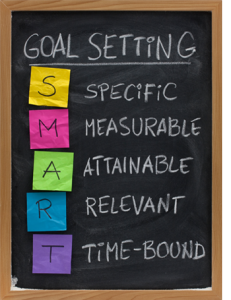Whether you are a non-profit organization, business driver, or entrepreneur, chances are you’ve heard plenty of people talk about how to set and achieve goals. The question is, how many of us truly utilize these skills we’ve been taught? The answer? Less than 25%. In part 2 of our series “Digging for Goals” we revisit some of the tried and true ways to set a goal. In part 3, we’ll go over how to actually achieve the goals we’ve established.
How to Set Successful Goals
Remember, Merriam-Webster defines the word goal as: the end to which effort is directed. Simply put a goal is the desired result of an action or multiple actions from an individual or group. Anything you want to acquire or achieve can become a goal.
S.M.A.R.T. Goals
Specific – To set a goal that can be achieved, your goals must be very detailed. It’s not enough to say you want to lose weight, reach the world, get more volunteers, or sell books. Those statements are very vague. Additionally, their achievement can be measured differently depending on which member of your team is working on them. One may see, “increasing volunteers” as getting 5 volunteers, wheras you were thinking more like 25 volunteers. The desire to sell books is a good one to have. But that vague goal should be quantified and given a precise number to achieve. If we aren’t specific with our goals, we will never know when we’ve achieved them. Or, we’ll begin to lose motivation because we don’t have the small markers of success needed to keep the engine driving.
 Measurable – Along the same lines of making our goals specific, we must also ensure they can be measured. There must be something in place that can show us how far we’ve come and how far we have left to go. One thing that will squash a person’s motivation, is the feeling that they are working tirelessly without actual movement. Having a goal where you can measure progress, enables the you, or or your team, to celebrate small victories, as well as identify setbacks. If we fall short, we’ll can then find out how and why, and be able to ascertain how close we came. Then, we can make adjustments so we will hit our target once we get back to the goal.
Measurable – Along the same lines of making our goals specific, we must also ensure they can be measured. There must be something in place that can show us how far we’ve come and how far we have left to go. One thing that will squash a person’s motivation, is the feeling that they are working tirelessly without actual movement. Having a goal where you can measure progress, enables the you, or or your team, to celebrate small victories, as well as identify setbacks. If we fall short, we’ll can then find out how and why, and be able to ascertain how close we came. Then, we can make adjustments so we will hit our target once we get back to the goal.
Attainable – All of our goals must be goals we can actually achieve. If we make unattainable goals for ourselves, we’re simply setting ourselves up to suffer failure. Is it realistic to lose 30 lbs in a week? No. In the same way it’s not realistic to follow up with 300 contacts in a day. Be sure to create goals that are possible, while at the same time, being sure not to be too easy on yourselves. While goals should be attainable, they should never be so easy that they require little to no effort, intelligence, or innovation.
Relevant – Put simply, does your goal matter? This goes back to understanding the purpose and value of our goals. If what we’re doing isn’t really that important to ourselves or those we are working with/for, then there is no reason to pursue that goal. Can you send out updates to all your current clients? Of course you can. But why? Do you have something in particular to update them about? Is it something they will care about? Is there a better way to achieve the same result?
Time Bound – All goals must have a deadline. That’s important enough to repeat. All goals, each and every goal you set, no matter when, no matter for what reason, should have a deadline. If there is no specific time frame it must be completed in, chances are it won’t get completed at all. When it is understood there is a time frame to complete the goal, people are often more strategic and effective. Goals that aren’t bound by time, are like driving with no destination. It’s pointless.
Finishing a marathon is a goal. Finishing a marathon in 3 hours is a better goal.
All Goals Should Inhabit These Qualities!!

Simple – Never make your goals too complex. If they are complex and confusing, you run the risk of throwing your hands up and abandoning the whole thing. The simpler you can make your goals, the easier they will be to attain, thus the more successful you’ll become. However, be sure your goals are stimple, yet still challenging. Don’t confuse simple with easy, these are two different concepts. A simple goal is clear, concise, and uncomplicated. It may still take strenuous effort, and much time, but you know precisely what you’ve been challenged to do.
Accountable – Find a way to hold yourself or your team accountable for your goals. Having a way to check up on the progress will make sure you stay on track. It can also make goals easier to achieve. Additionally, when there is a third party holding you accountable, it gives goal diggers the feeling of support knowing there is someone in your corner. This is always a good thing for people trying to achieve anything. One point to remember, don’t ask someone who is directly related to the goal and its achievement to be the person of accountability. History has taught us these people are more likely to “cut you some slack”. We don’t want that. We want true, hard-line accountability.
Share – Tell someone. Tell multiple people. Put it up in the office. Make it a big deal. This keeps us from being able to give ourselves too much grace in the things we want to accomplish. As much as we all love grace, goals are best achieved under structure and discipline. We know people are watching us, and waiting for us to succeed.
Down/Up (written down, posted up) – Use the down up process. Write down your goal, on paper, on a poster, on a flip chart, whatever you choose. Then, post it up. Put in on a wall in the office, on the front door of your bedroom, on every window in the building. Many teachers encourage goal setters to write their goals down. But we believe you must also post your goals up somewhere they can be easily seen. Be sure to post it somewhere you will see it regularly and in enough places that you can’t just take it down. This is not only another method of accountability, but it keeps the goal in the forefront of your consciousness. If not always at the forefront of your mind, certainly at the front of your sub-conscious.
Avoid Absolutes – Using words like always and never are goal setting suicide. Always never happens! It’s very difficult to find anything that always happens. We’re not talking about gravity and other absolute laws. But in most cases, there is not a single thing that never happens no matter what, or another thing that always happens no matter what. So, don’t use that verbiage in your goals setting. The goal isn’t, “never forget a client”. The goal should be to “ensure all are clients are responded to within 24 hours”.

There is another type of goal that can be set, in addition to the SMART goal. That is the B.H.A.G. or the “Big Hairy Audacious Goal”. This goal is so big, and so crazy you don’t have any idea how you could possibly accomplish it. It somewhat goes against the SMART concept of having goals that are attainable, BUT, it still works.
With the B.H.A.G., you must break your huge goal down into several smaller goal pieces. Staying consistent with your pieces will result in you inevitably achieving the B.H.A.G., and thus allows you to use the SMART concept for these smaller piece goals. A great B.H.A.G. is to “build the world’s largest _______” (you fill in the blank). Understand that B.H.A.G.’s aren’t for everyone. Only true visionaries and tenacious goal setters can conceive the Big Hairy Audacious Goal.








